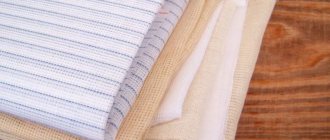What's wrong with synthetic clothing?
Moreover, synthetics are durable, since they are absolutely impervious to rotting and the effects of captivity. ... Another advantage of synthetics is its strength and wrinkle-resistance; it holds the shape of clothes perfectly. Also, many types of fabrics have water-repellent properties, which can be useful for sewing raincoats and jackets.
Interesting materials:
How long after dismissal? Whose are the Kuril Islands now? What's hot on Instagram 2022? What irritates you the most? What will happen to Vmenenka? What does melatonin do? What does origin access provide? What does an Origin Access Basic subscription provide? What does spinal stretching do? What does Riboxin do?
How to stretch a shrunken shirt
It often happens that after the next wash, the item becomes too small for you and the first thing that comes to your mind is that you have gained excess weight. But don’t rush to make hasty conclusions; perhaps you simply selected the wrong program in the automatic machine, or made other mistakes.
Let's try to figure out what to do if your shirt shrinks after washing:
- Your first action is to re-wash the product without adding detergents. It is very important to choose the right temperature; it should not exceed 30 degrees. Leave it in the basin for about twenty minutes, then take it out and let the excess liquid drain. It is very important not to squeeze, but to let it drain on its own.
Then spread a thick blanket on a flat surface; it should be light in color. Otherwise, color change will be added to this problem. Lay out the product and stretch it a little in all directions. To maintain its shape, secure the shirt with pins or special sewing needles.It is very important to turn the product over from time to time, otherwise it may suffocate and acquire an extremely unpleasant aroma. It also matters where exactly you lay it out to dry; the room should be well ventilated. The most suitable place is a balcony.
- Stretching on your own body. You need to wet the item in warm water and put it on. This method works well, but it cannot always be used; if in the summer it will be more or less comfortable to walk in wet clothes, then in the winter you risk catching a cold; in general, it’s up to you to decide how suitable this method is for you.
- Stretching using peroxide. Suitable only for white clothes; colored items may fade. Pour a couple of liters of cool water into a small bowl, then add 15 ml of peroxide and stir. Place the item there and leave it for an hour and a half. Afterwards, squeeze it a little and lay it out to dry; you need to periodically stretch it to give it the desired size.
- Soaking in an alcohol solution.
For five liters you will need 30 ml of ammonia, 10 ml of vodka or alcohol and the same amount of turpentine. Mix everything thoroughly and soak the item for half an hour. Afterwards, you need to rinse and send to dry in order to stretch better; when drying, lay the shirt on a towel and fix it. The combination of these components gives the product stretch characteristics, and due to this, it is more pliable. - Soaking in milk at room temperature for an hour and a half. The method is a little dubious, since after milk you will have to rinse for a long time, and the clothes may also acquire an unpleasant odor.
- Steaming.
Wet the clothes with a spray bottle, then lay them out on an ironing board and place damp gauze on top. Heat the iron, set the temperature appropriate for the type of fabric. While ironing, stretch the product and fix everything with an iron. If the fabric is dry, spray it again and continue the procedure until the expected result is achieved. - If individual elements have shrunk, for example, sleeves, wet them and hang them on a clothesline to dry, securing them with clothespins. And attach weights to the sleeves; their weight should be the same. They will pull back the fabric, thereby increasing the length.
- Using hair rinse or conditioner. Such products help make the fabric softer and more stretchable. You just need to soak the shirt for half an hour in cool water, then wring it out and stretch it.
- To use table vinegar, you need to dissolve four tablespoons of vinegar in ten liters of liquid. Then place the product there for an hour, then allow excess moisture to drain. Lay out to dry on a horizontal surface, stretching occasionally. Remember to turn over so the clothes don't suffocate.
How to prevent shrinkage
To prevent clothes from shrinking, you must follow the following rules:
- It is necessary to strictly adhere to the temperature regime during washing; the manufacturer indicates suitable washing conditions on the tag. Compliance with them will prevent damage to clothes.
- Washing and rinsing should occur with a minimum temperature difference.
- Choose the right care products.
- When loading the washing machine, sort your laundry by fabric type.
- You need to iron through gauze and at low temperature.
- Drying on a radiator or other similar device is prohibited.
- Do not use high speed centrifuges, and also avoid machine drying.
Washing thin cotton
There are several requirements here:
- Temperature – up to 60 degrees;
- Mode – delicate, washing time is not reduced;
- Rinsing is simple;
- Spin speed – maximum 600 rpm.
Using a tumble dryer is not recommended. Cotton lace is best washed by hand. Soak it in water with salt. Powder - depending on whether the fabric is colored or undyed. You don’t have to use a wringer, but simply wring things out with your hands. On lace and thin tablecloths, it is best to secure the design with pins and dry on the table.
Option two
Peroxide is needed here. You need a couple of tablespoons per bucket of water. We simply rinse the fabric in it and sometimes gently pull it in several directions.
Instead of peroxide, a mixture of turpentine and vodka (a couple of tablespoons each), as well as ammonia (three times more than turpentine) in a bucket of water, is also suitable. Again, rinse and pull. Then keep it in this mixture for 90 minutes and then squeeze it out a little. We dry it on a wet towel, sometimes stretching it. You can also add vinegar to the rinse water.
We suggest you read How to remove super glue from the skin of your hands: TOP 10 ways
Which fabrics used for sewing shirts are most resistant to deformation and shrinkage?
Synthetics are less susceptible to shrinkage. Among natural fabrics that are less susceptible to deformation are chintz, satin, and silk. If it contains elastin, clothes shrink after washing, and after a while they will return to their previous size. To avoid problems with deformation, it is recommended to follow the care instructions indicated on the label. The correct temperature and mode will allow you to keep the product in the same size. But if you couldn’t save it, you can correct the situation using the above methods.
How to pack a shirt
Types of shirts
The collar on a T-shirt is stretched: what to do and how to solve the problem
Surely you have encountered this unpleasant problem - the product is new, but the neck or collar has stretched unsightly after washing or normal wear. Don't throw away the item, it can be saved. You will need patience, as well as a needle and thread.
- Carefully open the collar placket - usually it is double. Divide it, make it single and longer. Sew together and you will have a longer strip of fabric for the trim.
- Take a T-shirt and use an iron to trim the stretched neckline, fold it in half along the shoulder seam.
- Take a strip of fabric, fold it in half, apply it to the shoulder seam of the T-shirt, pulling it slightly, sew it in a circle. Stop three centimeters before the joint. Connect the ends of the strip and sew them together, and hide the seam in the fold of the strip.
- Then sew the missing 3 centimeters to the neckline. The T-shirt is ready.
What to do if a wool sweater shrinks after washing?
If the product does shrink during machine washing, there are several simple ways to return it to its former shape. To do this, the jacket is again immersed in cold water and allowed to absorb a little liquid. There is no need to use powders or detergents. The sweater is then wrung out using a terry towel and laid out on a flat surface.
As it dries, you need to very carefully stretch the shrunken areas. You can also immediately attach the product to the base with a large number of pins, stretching it according to the desired size. It will take a lot of pins to ensure that all the parts are stretched and do not lose their original shape.
If the sweater becomes short after washing. It can be hung to dry on hangers. First, a towel folded several times is placed in the area of the shoulder seam. In this way, the housewife will avoid deformation of the jacket at the shoulders. The product will stretch under its own weight.
Particular attention should be paid to the cuffs and hem; they need to be stretched very carefully so as not to lose their shape. Otherwise, the sweater can be thrown out for being unpresentable.
Proper care of woolen items
The fact that a woolen item is ideal in terms of wear does not give it any advantages in care. On the one hand, it does not wrinkle and rarely gets dirty, but on the other hand, it requires special conditions in terms of washing, ironing and storage.
Wash.
It is best to wash woolen clothes by hand. By the way, there are special powders designed for washing woolen products, so it is advisable to use them. When washing by hand, the water should be no warmer than 30 degrees. Upon completion, the item does not need to be squeezed out. But if the water flows down a lot, you can blot it with a terry towel.
In cases where you have to use a washing machine, the operating mode should be set to either manual or delicate. The temperature mode selected is similar (30 degrees).
Ironing.
Ironing should be done without steam and using gauze. The item must be dry, and do not forget to set the iron to a special mode.
Storage.
In summer, woolen items should be stored in a closet, not forgetting about moth protection measures.
Without following the care conditions, the item can simply be ruined. Very often it settles, and returning its original appearance becomes problematic. But, using small tricks, you can try to do this.
Why do tissues become deformed?
Shrinkage is a change in the size of fabric after improper washing and drying, excessive steam and heat treatment. Your favorite sweater can easily shrink by a couple of centimeters if you do not follow the instructions for caring for it. The labels on clothes are sewn on for a reason - they tell you how to properly wash, dry and iron the item.
So why can any textile shrink in principle? The fact is that fabric is formed by weaving fibers together. The susceptibility of a material to deformation is influenced by the origin of the fibers and the method of weaving. For example, both satin and denim are made from cotton, and these are completely different products, subject to “shrinkage” to varying degrees.
Today, two types of fibers are used in production: synthetic and natural. The first ones are created on the basis of oil. Artificial polymers practically do not compress; organic threads are another matter. Natural fabrics are elastic; their weave is much looser, which leads to stronger stretching. This is how the structure of the material changes, the thing is deformed.










